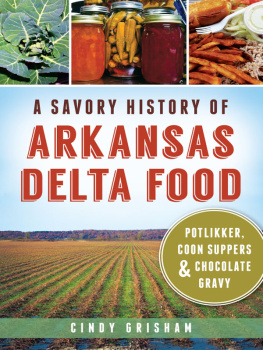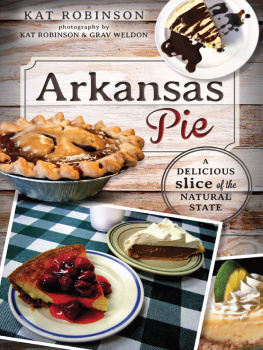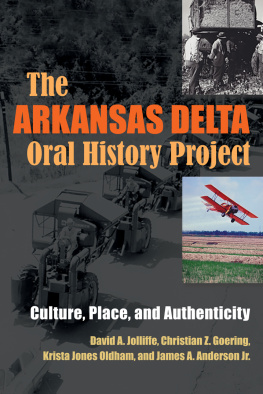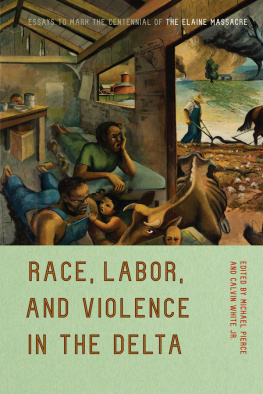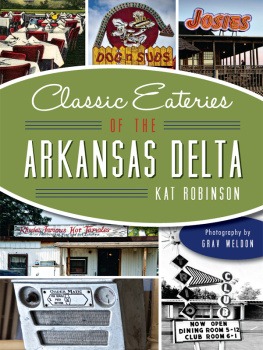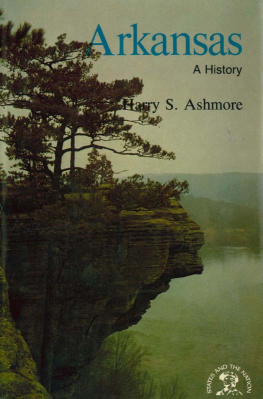
Published by American Palate
A Division of The History Press
Charleston, SC 29403
www.historypress.net
Copyright 2013 by Cindy Grisham
All rights reserved
All photographs by author unless otherwise noted.
First published 2013
e-book edition 2013
Manufactured in the United States
ISBN 978.1.62584.048.6
Library of Congress Cataloging-in-Publication Data
Grisham, Cindy.
A savory history of Arkansas Delta food : pot likker, coon suppers and chocolate gravy / Cindy Grisham.
pages cm
Includes bibliographical references and index.
print edition ISBN 978-1-60949-980-8
1. Food--Arkansas--Arkansas Delta--History. 2. Food habits--Arkansas--Arkansas Delta-History. 3. Cooking, American--Southern style. 4. Cooking--Arkansas--Arkansas Delta. 5. Arkansas Delta (Ark.)--Social life and customs. 6. Oral history--Arkansas--Arkansas Delta. 7. Arkansas Delta (Ark.)--Biography. I. Title.
TX360.U62A754 2013
641.59767--dc23
2013016428
Notice: The information in this book is true and complete to the best of our knowledge. It is offered without guarantee on the part of the author or The History Press. The author and The History Press disclaim all liability in connection with the use of this book.
All rights reserved. No part of this book may be reproduced or transmitted in any form whatsoever without prior written permission from the publisher except in the case of brief quotations embodied in critical articles and reviews.
CONTENTS
CHAPTER 1
THE OTHER DELTA
On ground so flat and low and marshy, lies a breeding-place of fever, ague, and deatha dismal swampteeming with rank, unwholesome vegetationa jungle deep and dark, with neither earth nor water at its roots, but putrid matter, formed of the pulpy offal of the two, and of their corruption.
Charles Dickens, American Notes (1842)
This is a story about food. Specifically, it is about the history and culture of food in the northeast corner of the state of Arkansas, an area not usually known for its cuisine. Then again, it isnt well known at all. The idea for it was born over a plate of biscuits and gravy on what my friends and I called Biscuits and Gravy Tuesday, which I will discuss in greater detail later on. Those afternoon conversations about our memories of food and family tended to drag on long after we had returned to work and grew to include many other friends and acquaintances. I learned long ago that people never grow tired of talking about the food they love and the people they love who cooked it for them. There is much to tell.
Northeast Arkansas lies in an area known as the Arkansas Delta (known locally as just the Delta), which is basically the same as the Delta over in Mississippi, except nobody knows as much about it. In 1935, a historian named David Cohn asserted that the Delta begins in the lobby of the Peabody Hotel in Memphis and ends on Catfish Row in Vicksburg. Cohns description has shaped the image of the region in the hearts and minds of a nation and the world, but it narrowed their vision of it as well. The Delta is as much a state of mind as it is a place, and it extends far beyond a few counties in northwest Mississippi. To understand the place better, you have to have a short lesson in geography and geology and history. It cant be helped, so here it goes.
The Delta is not actually a delta at all but rather an alluvial plainthe Mississippi River Alluvial Plain to be exact. An alluvial plain is nothing more than a flat piece of land that was formed by sediments left lying around after floods, which means that most of the Delta used to be someplace else. This Mississippi River Alluvial Plain is subdivided into three smaller regions. The first is the well-known area called the Mississippi Delta. Now, it really is a delta, although not of the Mississippi but of one of its tributaries, the Yazoo. The center of this region is Greenville, Mississippi, a town that calls itself the Heart and Soul of the Delta. Greenville is known for its writers and historians. People like William Alexander Percy, whos Lanterns on the Levee: Recollections of a Planters Son sets the stage for the Delta as most of us know it, or Shelby Foote, the historian of the Civil War.
The second region is called the Mississippi River Delta and lies in southern Louisiana. It actually is the real delta of the Mississippi. The heart of this region is New Orleans, a city well known for its quirky charm, beautiful architecture and good times. The third part of the plain is called the Mississippi Embayment. It takes in a little tiny corner of northeastern Louisiana, all of eastern Arkansas and the extreme southeastern corner of Missouri. The heart of the embayment is Memphis, which in spite of its metropolitan identity is still just a big old country town. The lower part of the embayment is historically similar to the Mississippi Delta on the other side of the river. The land was settled before the Civil War, with large sections of timbered land cleared by slaves, who later toiled there to grow cotton. The upper part was settled much later and because of that has a history and culture that, though similar to the rest of the Delta, is a world all its own.
Within the Mississippi Embayment, there are smaller areasthree to be exactthat need to be explained as well. The first is Crowleys Ridge, a geological oddity that pushes up out of the flat farmland that surrounds it. Known locally as the Ridge, it rises from 250 to 550 feet above the alluvial plain, stretches from 0.5 to 12.0 miles in width and runs for 150.0 miles from a point in southeast Missouri directly across the river from a town called Thebes, Illinois, all the way to the Mississippi River town of Helena in Phillips County, Arkansas. It is covered with a soil called loess, which means that it was deposited by the winds rather than the water. If you spend much time in the Delta, you will quickly understand how the wind could have left all that dirt. No one can agree on its origin, with some believing that it was the land between the old beds of the Mississippi and Ohio Rivers and others thinking that it may have been pushed up by the New Madrid Seismic Zone, which lies underneath and has from time to time caused a great deal of trouble. The plants and animals that inhabit the Ridge are strangely similar to those in the Appalachian Mountains. Because it was high land, above the flooding of the lowlands surrounding it, the Ridge was the first place settled in the region.

Looking across a cotton field toward Crowleys Ridge, near Weona in Poinsett County.
On the western side of the Ridge lie the Western Lowlands, whose sediments come primarily from the White River but also from streams with names like the Cache, the LAnguille and Bayou de View. It is low and swampy but fertile, and it is here where much of the worlds rice is grown. On the eastern side of Crowleys Ridge lies the Eastern Lowlands. There, the sediments come not only from the Mississippi River but also from the St. Francis, Little and Tyronza Rivers. This has historically been the cotton growing region.
Arkansas has often seemed to be at the wrong place at the wrong time, with its geography primarily to blame. Although it lies right across the Mississippi River and would have been one of the first places new settlers would have entered going west, the swampy lands on the eastern side were so difficult to cross that most people went north to Missouri or south to Louisiana, where travel was easier. Roads were next to impossible to construct, and although the terrain was crisscrossed with rivers and bayous, they were only navigable part of the year. In 1822, Congress appropriated money to construct a federal highway, a military road from the Mississippi River near Memphis to Little Rock, and appropriated $26,000 to complete the project, a fairly princely sum at that time. It took the entire amount just to cross Crittenden County, and the officer in charge begged to go to some nice northern climate.
Next page
